The musical scores for all the Star Wars Episodes were composed by John Williams. The scores of the spin-offs have been written by various different composers. The music for the films are especially distinctive as it has been known to paint musical pictures of such accessibility and precision, and Williams's invaluable contribution to the Star Wars saga and story films stands as an unsurpassed feat in the history of film scoring in terms of breadth, thematic-development and cultural impact.
The scores utilize an eclectic variety of musical styles, many culled from the Late Romantic idiom of Richard Strauss and his contemporaries that itself was incorporated into the Golden Age Hollywood scores of Erich Wolfgang Korngold and Max Steiner. While several obvious nods to Holst, Walton, and Stravinsky exist in the score to A New Hope, Williams relied less and less on classical references in the latter five scores, incorporating more strains of modernist orchestral writing with each progressive score. The reasons for Williams's tapping of a familiar Romantic idiom are known to involve Lucas's desire to ground the otherwise strange and fantastic setting in well-known, audience-accessible music. Indeed, much of the trilogy's success relies not on advanced visual effects, but on the simple, direct emotional appeal of its plot, characters, and, importantly, music.
Star Wars is often credited as heralding the beginning of a revival of grand symphonic scores in the late 1970s. While to ascribe this feat single-handedly to Williams is premature, the popularity and impact of the scores was a major contribution. One technique in particular has had a particular influence: Williams's revival of a technique called "leitmotif", which is most famously associated with the operas of Richard Wagner and, in film scores, with Steiner. A leitmotif is a phrase or melodic cell that signifies a character, place, plot element, mood, idea, relationship, or other specific part of the film. It is commonly used in modern film scoring, as a device to mentally anchor certain parts of a film to the soundtrack. Of chief importance for a leitmotif is that it must be strong enough for a listener to latch onto while being flexible enough to undergo variation and development.
- Star Wars Main Title or Luke's Theme (all episodes and spin-offs). The "anthem" of the saga, Williams's instantly recognizable main theme is variously associated with Luke, heroism and adventure. It is heard in full Korngoldian splendor over the opening crawl at the beginning of all the films, and part of the music is heard over the credits. Most prominent in the first film (Episode IV) in which strong brass treat it as a fanfare of sorts for Luke, the theme is relied upon less and less frequently throughout subsequent films, though its emotional impact is always pronounced. Except for the final scene of Episode III, Williams's use of the Main Theme in the prequels is limited mostly to the title crawl and short, sometimes disguised fragments.
- Rebel Fanfare (all episodes and spin-offs). This short motif is used extensively in Episode IV to represent the Rebel Alliance. It is used occasionally in Episodes III and V for this purpose as well. The theme itself is constructed out of brassy major block chords that progress in parallel motion through intervals of a third, resulting in an appropriate heraldic flavor. In the radio dramatization of Star Wars Episode IV: A New Hope the Rebel Fanfare was used as the backing music for the Imperial recruitment tape that Luke listens to in "A Wind to Shake the Stars." In the transcript for "Black Knight, White Princess, and Pawns," it was identified as "Vader's music."
- The Force Theme or Ben Kenobi's theme or Jedi Knights and the Old Republic theme (all episodes and RO). This theme represents Obi-Wan Kenobi, the Jedi and most importantly the Force from which they draw their power. It also often represents the twin themes of destiny and fate that are important in all the films. It is the most commonly heard and prominent theme over the six films as a whole, and undergoes substantial development especially in the prequel trilogy.
- Princess Leia's Theme (III, IV, V, VI, VII, VIII, IX and RO). A romantic theme for PrincessLeia, one of the central protagonists of the Original Trilogy. This theme represents her "innocence", and hence is most often heard in Episode IV, but is used in the next two films when she is acting on her own or when she is particularly vulnerable. It is heard prominently in Episode III after she is born. Williams made an extended concert version of this theme that is performed frequently.
- Imperial motif (IV, RO and S). Not to be confused with the Imperial March, this motif represents the Empire and Darth Vader strictly in Episode IV (although it was referenced on numerous occasions), before the much more popular Imperial March was written. Vaguely militaristic, it is generally played by bassoons or muted trombones, and for its brevity and limited melodic scope, is not nearly as successful at conjuring dread as the Imperial March.
- The Death Star motif (IV, VI, VIII, RO and S). An imposing four chord motif, played six times during Episode IV, that either heralds a shot of the Death Star, or is played when that place's presence is suggested (for example when a ship is going to fly there). Also heard in Episode VI, though through music that was adapted from the first film. In RO it appeared as it was intended by Williams, while S quoted it probably for the sake of nostalgia.
- Jawa Theme (IV). A jaunty theme used in Episode IV when the droids land on Tatooine, and then for much of the following half hour of the film. It is mostly associated with the oboe and English horn.
- Tatooine motif (IV, I, II). This motif borrowed heavily from Stravinsky's The Rite of Spring, little more than a melodic contour (up by small interval, down by big interval) that crops up with wide shots of arrival on Tatooine.
- Victory March (IV, VI). Walton-esque music played during the medal ceremony at the end of Episode IV. Williams develops it into a set of chromatic variations during the scene in Return of the Jedi in which the Rebel fleet takes off into hyperspace. A longer rendition was written and recorded later. This extended version was also recorded for the album version of the end credits for Episode III.
- The Imperial March or Darth Vader's theme (V, VI, I, II, III, VII, RO, VIII, S and IX). The theme that represents the authoritarian Galactic Empire as a whole, and Darth Vader specifically. It is so successful that it has entered the Western consciousness as a general "evil theme", and as such is played at a huge variety of public events. In the Prequel Trilogy, it is subtly at first, being partially embedded in Anakin's innocent theme, though with progressive prominence it is heard through Episodes II and III, signaling critical points in Anakin's downward spiral to the dark side, as well as the rise of the Empire. Examples of the latter include the piece played at the end of Episode II when the Republic military is boarding assault ships and in Episode III when the Republic AT-RTs are scouting Kashyyyk for Jedi survivors. In the Original Trilogy, The Imperial March also represents all that is the Empire; therefore, it is nearly equivalent to a galactic anthem. Its first appearance is played by a solo piccolo. It is played one final time during Vader's death in Episode VI, tenderly on harp, as finally Vader returns to the light of the Force. It is absent from Episode IV simply because Willams hadn't written it until Episode V, and then kept it onwards. The motif appears once in Episode VII, closing the scene in which Kylo Ren is addressing Darth Vader's disfigured mask. The motif also appears briefly in Episode VIII in the initial throne room sequence between Snoke and Kylo Ren as Snoke mentions the fact that his goal was to groom Kylo Ren to be the next Darth Vader.
- Han Solo and the Princess or the Love theme (V, VI, VII, VIII and IX). A theme for the love between Han Solo and Princess Leia. Heard in Episodes V and VI, and often used in not only scenes of romance but also scenes of sacrifice from the two characters.
- Yoda's Theme (V, VI, I, II, III, VIII and IX). A theme meant to represent the age and gentle wisdom of Jedi Master Yoda, who appears in five of the six films along with his music. Played often when the diminutive green character is on screen, particularly when he is either using or teaching about the Force, it is often used when his presence is implied, or his influence felt (such as during the Cloud City sequence in Episode V). Used more sparingly in the Prequel Trilogy, though certain moments, such as Yoda's duel with Count Dooku and his departure from Kashyyyk, highlight the theme quite prominently.
- Droids motif (V). A short playful motif associated with C-3PO and R2-D2. Fairly prominent in several scenes on Hoth, Dagobah, and during the climactic "Hyperspace" cue at the end of the film. The motif is not heard in any other film.
- Boba Fett motif (V). A descending two-note bassoon phrase relating to the quiet menace of bounty hunter Boba Fett. It is played three times in Episode V (when we see Boba Fett in Vader's Starship; when he goes after the Millennium Falcon (just after the Asteroid Field sequence); and when Lando betrays his friends in Cloud City. Linked with Boba Fett's theme (Episode V).
- Lando's March or the Cloud City march (V). This theme is heard a few times in Lando's Palace during the Bespin sequences of Episode V. It is a march in Major mode.
- A recurring, untitled motif during the final Cloud City sequences is also present, though it has not been described as being connected to any particular character, location or idea. Described as an 'ascending horn and wind motif' in the Special Edition soundtrack liner notes, this motif is heard during some scenes involving Boba Fett, leading to the wide but unfounded belief that it is a second theme for the bounty hunter. There is some outward similarity between the two themes, but this may be coincidental.
- Jabba's Theme (VI and I; IV in post-1997 releases). A rolling, bulbous tuba theme for the slug-like Jabba the Hutt, it is played often during the opening act of Episode VI, which takes place at Jabba's Palace, and then again, masked but clearly there, in grandiose fashion during the Pod Race sequence in Episode I.
- The Emperor's Theme (VI, I, II, III, VIII and IX). The theme for Darth Sidious, who then becomes Emperor Palpatine, and to a lesser extent also represents the Dark Side of the Force. A relatively simple chord progression, it is often sung by a male choir, or played on a deep instrument such as a bassoon. In Episodes I and II, it is used to represent the growing power of the mysterious Darth Sidious, and in Episode III it is played as Sidious' true identity is unmasked and he lays the foundation for the Empire. In Episode I, it is also used—albeit sped up and in a major key, and sung by children—during the victory celebrations at the end of the film. In Episode VI, it is used to represent the Emperor, and plays whenever he is on screen.
- The Ewoks Theme or Parade of the Ewoks (VI). It is the theme for the Ewoks, who live on the forest moon of Endor. It is played at the Ewok village, during the forest battle and in the End Credits of Episode VI.
- Luke and Leia (VI, VIII and IX). The theme for the link between Leia and her brother Luke. Heard in Episode VI only twice in the actual film; the concert suite that Williams composed for it is clearly longer than the sum of its uses. Composed in the Romantic tradition, it is tragic, spirited and uplifting all at once.
- Ewok Celebration (VI, elements in I). The song that was played before the credits in the original version of Episode VI. It mostly uses primitive percussion instruments, reflecting the crude technology of the Ewoks. The lyrics of this theme are sung entirely in Ewokese, which was not restricted to set words during its creation. In the re-release of Episode VI, it was replaced in the 1997 special editions by a piece known as "Victory Celebration", which is scored for full orchestra and choir. Elements of this theme are likely present in the parade scene of Episode I.
- Anakin's Theme (I, II and III). A tender, beautiful theme, with a tragic and sickening flaw—it represents the innocent, boyish Anakin, but, like him, it contains evil. The theme, if listened to carefully, follows the Imperial March, and ends with a number of subtle renditions of phrases from that theme, and foreshadows what will ultimately come to pass. Development is limited almost exclusively to Episode I, with a small handful of renditions in Episode II and a single, tortured rendition in Episode III.
- Droid Invasion Theme (I, II, and III). Also known as the Trade Federation March, it is played various times in Episode I as the droid armies of the Trade Federation attack Naboo. In Episode II, it is used to represent the Clones, who will eventually come to replace the droids as the Empire's soldiers of choice. A variation of the theme known as "Activate the Droids" is played in the Arena Battle, and also heard in the Battle of Kashyyyk. A similar theme, regarded as a variation, was written for the arena scenes in Episode II, but was mostly unused. This rendition is tracked into Episode III during the arrival at Kashyyyk and Anakin's march on the Jedi Temple.
- Duel of the Fates (I, II, III and S). This symphonic piece is played with a full orchestra, as well as choir that chants an archaic Celtic poem "Gad Goddue" (Battle of the Trees) in Sanskrit. In English, the poem (or line that Williams uses) reads: "Under the tongue root a fight most dread, and another raging behind, in the head." In Episode I, it is played near the end during the fight with Obi-Wan, Qui-Gon and Darth Maul, and developed substantially in music that didn't make the final cut of the film. In Episode II, it is played when Anakin goes off to search for his mother, again representing a key point in determining Anakin's fate. In Episode III, it is played when Yoda fights Emperor Palpatine, in the final battle that could change the destiny of the galaxy.
- Shmi's Theme (I and II). Oboe melody heard when Anakin departs from his mother in Episode I, and again at the moment of her death in Episode II.
- Funeral Theme (I and III). Another setting of poetry in Sanskrit. Heard briefly during Qui-Gon's funeral in Episode I, and in Episode III during the death of Padmé and the "rebirth" of Darth Vader in his suit. A softer version without a choir is played Padmé's funeral procession, and blended with Imperial March during the shot of the skeletal Death Star.
- Qui-Gon's Theme (I). Heard three times in film, during beginning of "Leaving Home" cue, the desert duel with Maul, and at the end of the Battle of Naboo. It only appeared in the Ultimate Edition of the released Soundtrack.
- Jar Jar's Theme (I). A Theme for the clumsy Character Jar Jar. Heard when he is introducing himself to Padmé on the ship, and when he is chasing the pit droid in Watto's shop.
- Across the Stars (II and III). The broadly romantic theme associated with the forbidden and ill-fated love between Anakin Skywalker and Padmé Amidala. The title is probably a reference to Romeo and Juliet, a story of similar "star-crossed" doomed love. It is gentle but with an undercurrent of unease and uncertainty. It is written in the key of D minor, but modulates several times throughout its duration. A secondary theme appears within the concert arrangement, as well as during the Fireplace Scene in Episode II and as Anakin and Padmé first meet in Episode III. Arguments have been put forward that in it's melodic and rhythmic structure, the theme bears resemblance to Luke and Leia's themes from the original trilogy, though such features as prominent triplets speak more to common ideas throughout Williams scores (note resemblance to themes from Hook and Nixon, for example).
- Conflict motif (II) and Mystery motif (II and III). Brooding minor motif, arguably the same. It has been compared to Across the Stars, and appears to have a similar structure.
- Anakin's Descent motif (II and III). A repeated minor figure, Bb-A-Bb-G-C-A-Bb-G that is given a long sequential treatment in Anakin's Confession scene, and is embedded into "Anakin's Betrayal."
- Kamino Motif (II). A series of arpeggiations of a minor chord. Obviously limited in usage. Also played twice during Geonosis scenes, with Count Dooku fleeing in both instances.
- Dooku motif (II). A possible motif, roughly D-Eb-C# (a common melodic figuration for Williams) that occurs as a kind of orchestral stinger during a couple of scenes in the latter portions of the film.
- Palpatine's machinations motif (II, III, IX). A motif which relating to the machinations of Darth Sidious.
- Mourning Theme (II). Moving theme, with characteristic upward ascending minor 6 in solo horn. Heard at least three times, but given fullest treatment during Shmi's funeral.
- Battle of the Heroes theme (III). The theme for the climactic, apocalyptic duel between Anakin and Obi-Wan. The piece starts off with stridently syncopated strings, immediately joined by horns and a choir that heralds the main phrase: an ascending and descending motif that ends in a cliffhanger. At first, the theme may seem incomplete, but this suits the background of the scene which it supports: the climactic and uncertain duel between Anakin and Obi-Wan. The piece crescendos with rumbling drums, swirling harps and crashing cymbals into the middle part. The vigorous and pulsating choral echoes a fierce and relentless duel. The second part repeats the main phrase, as well as featuring the Force theme, which binds this piece to the rest of the saga's music. Battle of the Heroes ends with a thunderous, though false ending, then the manic strings from the beginning are heard again before finally coming to a rumbling conclusion. It is developed substantially during the final battle in a variety of guises.
- Anakin's Betrayal (III and IX). The music played during the Order 66 sequence, and again during Anakin's final confrontation with Padmé. Melodic contour links with "Anakin's Descent Motif."
- Anakin's Dark Deeds (III and VIII). The music played during the scene of the killing of the Separatist Council by Darth Vader, his emotional strugle with the dark side, and to some extent Palpatine'stransformation of theGalactic Republic into the Galactic Empire.
- Grand Army of the Republic Theme/Arena Theme (III). Major key, predominantly brass theme. Symbolising the clone troopers and the Republic military. Occurs initially with the introduction to the Battle of Kashyyyk, later with the siege of the Jedi Temple and the Republic's victory in the Battle of Utapau.
- General Grievous' Theme (III). Plodding, over-dotted theme that occurs with introduction of General Grievous, given extended treatment during his arrival on Utapau and reoccurs during beginning of lightsaber fight with Obi-Wan.
- Legend of the Sith (III and IX). A hypothetical motif that occurs subtly in the Palpatine seduction scene. It also heard at the beginning of Episode IX during scene of Kylo and Palpatine meeting.
- Arrival Theme (III). Unreleased theme, given full treatment during cue "Another Happy Landing" which accompanies the successful landing on Coruscant. Also heard as Obi-Wan arrives at Utapau, and again as he leaves Tion Meddon.
- Padmé's Ruminations (III). Heard before Mace Windu's battle with Darth Sidious.
- Rey's Theme (VII, VIII and IX). A delicate sounding leitmotif scored by instruments like the flute, piano and celesta.
- Kylo Ren's Theme (VII. VIII and IX). A cousin of the Imperial March designed feel slightly more hesitant, in lieu with the character. In the context of the new trilogy it is most closely related to Rey's theme; in fact, the two themes are almost precisely the retrograde inversion of one another, which at the very least represents that the two characters are similar but opposed to one another.
- Snoke's Theme (VII and VIII). A low, almost Gregorian chant heard whenever he is speaking.
- March of the Resistance (VII, VIII, S and IX). A bold but tense minor-key march played as the Resistance prepares for battle; bears a striking resemblance to Episode I's Trade Federation March.
- A recurring motif in 11/8, first played during Finn and Rey's escape from Jakku (VII). This motif is played throughout the movie during exciting scenes and battles.
- Poe's Theme (VII, VIII and IX) is repeated throughout the film whenever Poe is flying. It shares similarities with "Rey's Theme".
- Jedi Steps theme (VII and VIII). A slow, mysterious, repeating motif that gradually crescendos as Rey ascends the steps at the end of the film, building into the Force Theme as the film's final cliffhanger arrives.
- Rose Tico's Theme (VIII). A two-phrase theme that conveys the innocence of the Resistance fighter.
- Luke in exile motif (VIII). A leitmotif first appears as the "hesitance sarabande," representing Luke Skywalker's hesitance to join the fight against the First Order. The motif later sounds as a fanfare during a montage of the Jedi exile's life on Ahch-To.
- Desperation Motif (VIII). A rhythmically unstable motif that represents the struggle of the characters within the story.
- Last-ditch fanfare (VIII). A fanfare that appears in scenes, that involve the Resistance making a last-ditch effort.
- Hesitance Sarabande (VIII). A Sarabande that represents Luke's hesitance to join the fight.
- Holdo's Theme (VIII). The Theme for the Resistance Admiral's most notable appearance is while she performs the Holdo maneuver.
- Luke's Interference (VIII). This Do-So-Me-Do motif was heard, prior to the release of the film, in the trailers, but also appears right before Luke engages Kylo Ren on Crait.
- Trio/Fellowship/Friendship Theme (IX). A flourishing theme that represents the friendship between Rey, Finn, and Poe as well as the trio's compassion for other characters like D-O.
- Victory Theme (IX). A primary theme that plays during the Resistance's last stand against the First Order.
- Anthem of Evil (IX). A sinister piece used to represent Palpatine and the Final Order.
- Knights of Ren (IX). A sinister piece used to represent the Knights of Ren.
- Poe's Heroics (IX). An expansion of Poe's Theme from the previous films.
- Ben Solo's Redemption (IX). A short, somber theme to represent Ben Solo's turn.
- Jyn Erso's Theme (RO). The theme for the protagonist was heavily inspired by the Gregorian chantDies Irae.
- Hope Theme (RO). This theme shares many similarities with Luke's theme.
- The Imperial Suite (RO). This two-phrase theme represents the Empire strictly in Rogue One. Not to be confused with the Imperial March or the Imperial motif.
- Krennic's Theme (RO). This two-phrase theme represents Imperial DirectorOrson Krennic.
- Guardians of the Whills (RO). This two-phrase theme represents the Guardians of the WhillsBaze Malbus and Chirrut Îmwe.
- The Adventures of Han (Composed by John Williams) (S). The two-phrase theme represents either Han as a hero, or Han's search for purpose.
- Crimson Dawn (S). A theme representing the Crimson Dawn
- Qi'ra & Han (S). A love theme for the romance between Han Solo and Qi'ra.
- Han & Chewbacca (S). A theme representing the friendship of Han Solo and Chewbacca.
- Chewbacca's Theme (S). A theme representing the Wookiee Chewbacca.
- Beckett's Theme (S). A theme representing Tobias Beckett.
- Enfys Nest (S). A contemporary stylized theme for Enfys Nest, utilizing a Bulgarian choir.
- L3-37 (S). A theme for the droid L3-37.
- Cantina Band and Cantina Band #2 (Episode IV). Played in the Cantina on Tatooine. It is written for solo trumpet, saxophone, clarinet, Fender Rhodes piano, steel drum, synthesizer and various percussion and is notable for not having a traditional cadence at the end.
- Jabba's Baroque Recital (Episode VI). A highly ornamented organ-like piece with harpsichord, complete with alberti bass motion. It is presented in 3/4 time, much like a waltz, and is in A-B-A-C-A(ornamented) form.
- Jedi Rocks (composed by Jerry Hey) (Episode VI). This was composed to replace a piece of music called Lapti Nek, which was replaced for the 1997 Special Edition of the film. It is highly rock-influenced, with prominent organ, horn, and electric bass parts.
- Sail Barge Dance (Episode VI). Heard twice in the film, once after Jabba sends the Wookiee Chewbacca to jail, and again on Jabba's Sail Barge (hence its title). Recordings lost forever.
- Ewok Feast and Part of the Tribe (Episode VI). Comprised exclusively of various percussion.
- Tatooine Street Music (Episode I). Williams wrote four separate pieces of highly chromatic, vaguely Eastern sounding source music for the streets of Mos Espa.
- Augie's Municipal Band (Episode I). Celebratory song at the conclusion of Episode I. Melody is based on that of the Emperor's theme from Episode VI, albeit in major—a subtle clue as to the true identity of the senator from Naboo.
- Dex's Diner (composed by Joseph Williams) (Episode II). Heard playing in Dex's diner. Standard twelve-bar blues-style song with fast tempo and 1-3-5-6-flat 7 arpeggiations.
- Victory Celebration (Episode VI). New song for the ending of Episode VI's Special Edition release.
- The Flag Parade (Episode I). The Flag March for the opening of the Boonta eve Podrace.
- Jabba Flow (Composed by Lin-Manuel Miranda and J. J. Abrams) (Episode VII). This song played at Maz Kanata's castle.
- Dobra Doompa (Composed by Lin-Manuel Miranda and J. J. Abrams) (Episode VII). Another song which played at Maz Kanata's castle. Currently unreleased.
- Canto Bight (Episode VIII). The casino on Cantonica.
- Chicken in the Pot (Composed by John Powell) (Solo).
- Lido Hey (Composed by Lin-Manuel Miranda and J. J. Abrams) (Episode IX). Celebratory song which played during Aki-AkiFestival of the Ancestors on Passana. Currently unreleased.
- Oma's Place (Composed by Ricky Tinez and J. J. Abrams) (Episode IX). Song which played in the bar owned by Oma Tres (featuring John Williams in a cameo role) on Kijimi. Currently unreleased.
- Princess Leia's Theme (Episode IV).
- Here They Come! (Episode IV). A concert version of the piece that plays when the Millennium Falcon is pursued by TIE Fighters after escaping the Death Star. It has not appeared in the film in this form.
- The Battle (Episode IV, Episode VI). It is a combination of the Final Battle cue from Episode IV and the Superstructure Chase cue from Episode VI. It has not appeared in any of the films in this form.
- The Throne Room (Episode IV). An expanded version of the Victory Celebration theme from Episode IV. A version of this was used in the soundtrack for Star Wars Episode III: Revenge of the Sith.
- The Imperial March (Episode V). Premiered in a Williams concert five weeks before the movie was released.
- Yoda's Theme (Episode V). Premiered in a Williams concert five weeks before the movie was released.
- Han Solo and the Princess (Episode V). The love theme for Han Solo and Princess Leia. The complete concert suite has never been performed by Williams himself but has been performed by The City of Prague Philharmonic, Charles Gerhardt, for his recording of The Empire Strikes Back and by Roy Budd and The London Symphony Orchestra.
- Jabba the Hutt (Episode VI).
- Parade of the Ewoks (Episode VI). Mostly played during Leia's first meeting with Wicket, and also appears in the Forest Battle concert suite.
- Luke and Leia (Episode VI). Played only on a few occasions in the film, but is also strangely missing from Episode III.
- The Forest Battle (Episode VI). It is a concert suite of The Ewok Battle, which is part of the Battle of Endor.
- Anakin's Theme (Episode I). This is a concert suite of Anakin's theme which is heard many times through the film.
- Duel of the Fates (Episode I). Though edited in the final film, nearly the entire theme appears in the final duel.
- Across the Stars (Episode II). It features a slow and tranquil opening, utilizing the oboe and strings heavily. Nearly the entire theme is underscored with triplet arpeggios. Finally, the end of this musical composition features a haunting solo by the harp, repeating the initial theme with colorful ornaments.
- Battle of the Heroes (Episode III). Although this cue sounds very much like a concert suite and was even released as a single, most of it was used as-is in the film.
- March of the Resistance (Episode VII).
- Rey's Theme (Episode VII).
- Scherzo for X-Wings (Episode VII).
- Jyn Erso & Hope Suite (Rogue One).
- The Imperial Suite (Rogue One).
- Guardians of the Whills Suite (Rogue One).
- The Rebellion is Reborn (Episode VIII).
- The Adventures of Han (Solo).
- Anthem of Evil (Episode IX)
- The Rise of Skywalker (Episode IX)

2018 Walt Disney Records CD.
The Star Wars score was recorded in eight sessions at Anvil Studios between March 5 and March 16, 1977 by the London Symphony Orchestra. The orchestrations were made by , who also made the orchestrations for Episode V and VI. The movie was premiered on May 25, 1977 and by late summer a disco version became America's number one song. Williams received in February 1978 three Grammys and his third Academy Award in April.
First released on LP by 20th Century, John Williams selected seventy-four minutes of music out of the eighty-eight-minute score for the original soundtrack. To provide musical variety, it did not follow the chronological order of the film.
in 1997 (RCA Victor), and 2004 (Sony Classical), respectably, the complete score was released in chronological order for the first time. The two releases present exactly the same track listing. The only difference between these editions is that the RCA release includes complete notes on each track by and that the Sony Classical release does not include these notes.
Now Available on Walt Disney Records (2018), the latest release is a remastered version of the original soundtrack. supervised by Shawn Murphy and Skywalker Sound, this version was transferred to a new hi-resolution (24/192), and was derived from the original film mixes, not the remixed LP versions, which had been previously released.
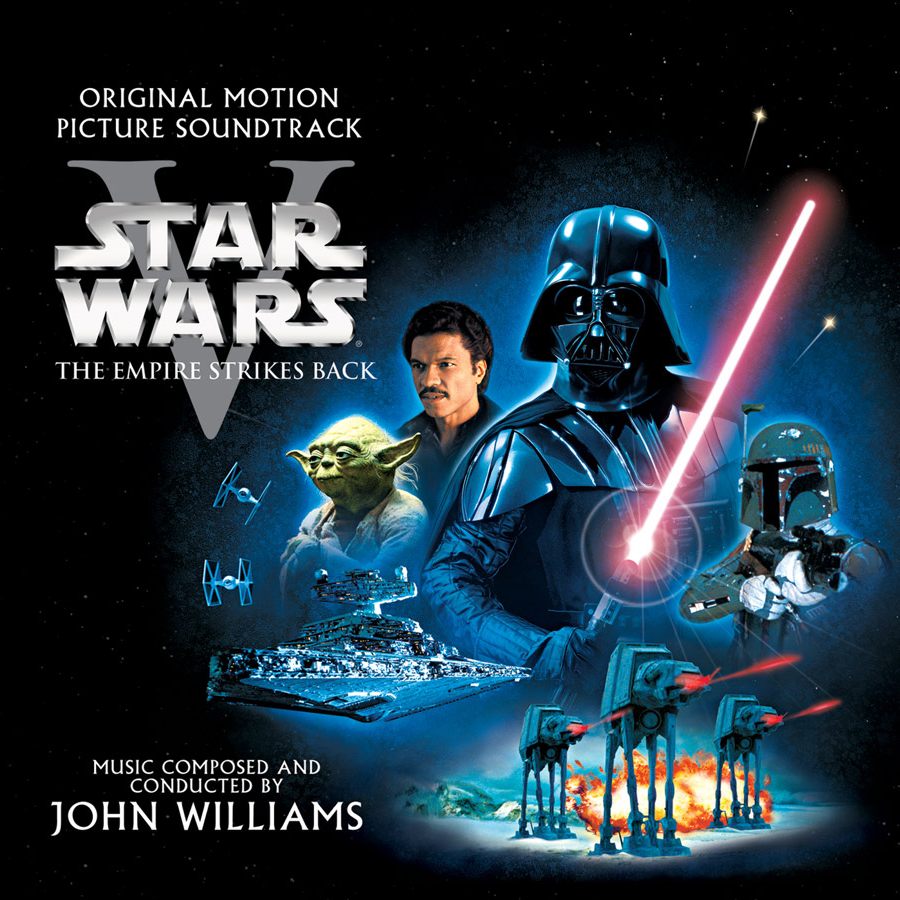
2004 Sony Classical CD.
The Empire Strikes Back score was recorded in eighteen sessions at the Anvil Studios and the Abbey Road studios in December 1979 and January 1980 by the London Symphony Orchestra. Between Star Wars and The Empire Strikes Back, Williams had also used the London Symphony Orchestra for The Fury, Superman and Dracula. The score won another Oscar nomination for Williams.
The soundtrack was first released as a seventy-five-minute double LP (released five days before the premiere of the film), but the first compact disc release ran only half the length of the 2 LP set. Re-recordings of the score even included music that was not on the CD soundtrack!
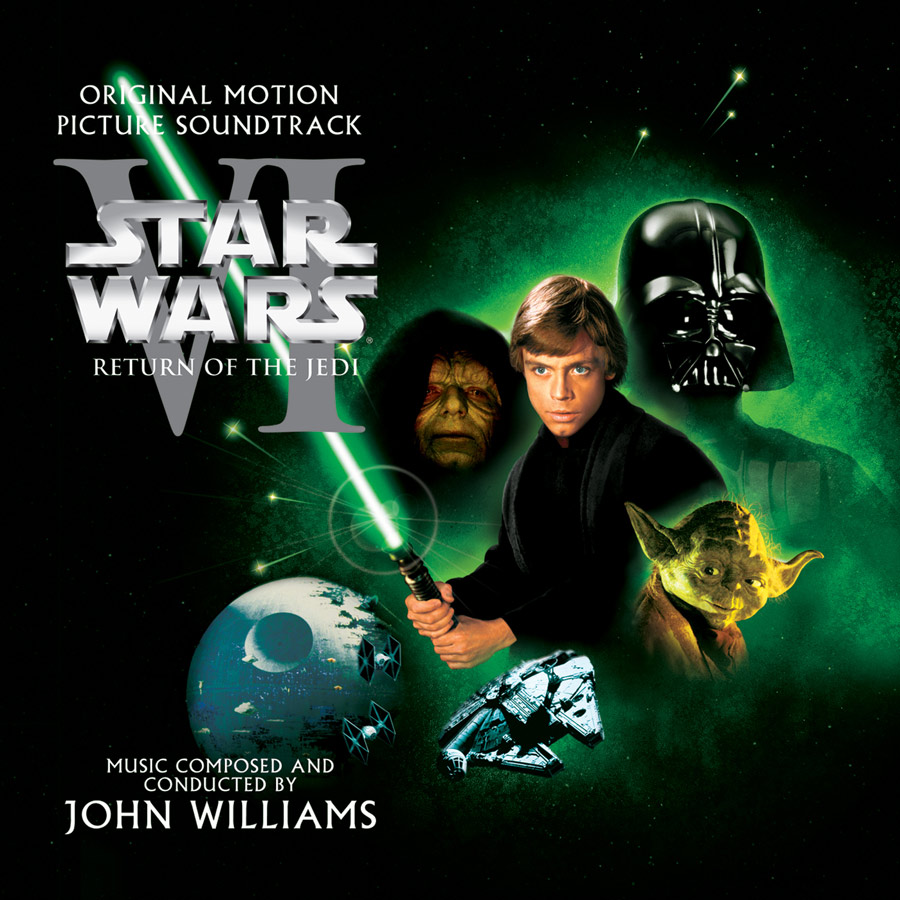
2004 Sony Classical CD.
The Return of the Jedi score was recorded at the Abbey Road studios in January and February 1983 by the London Symphony Orchestra. The score won another Oscar nomination for Williams. Herbert W. Spencer, Thomas Newman and Gordon Langford served as orchestrators. Because of the decrease of popularity for the vinyl format, Return of the Jedi, which is the longest score of the Original Trilogy, was only release on one LP instead of two like Star Wars and The Empire Strikes Back.
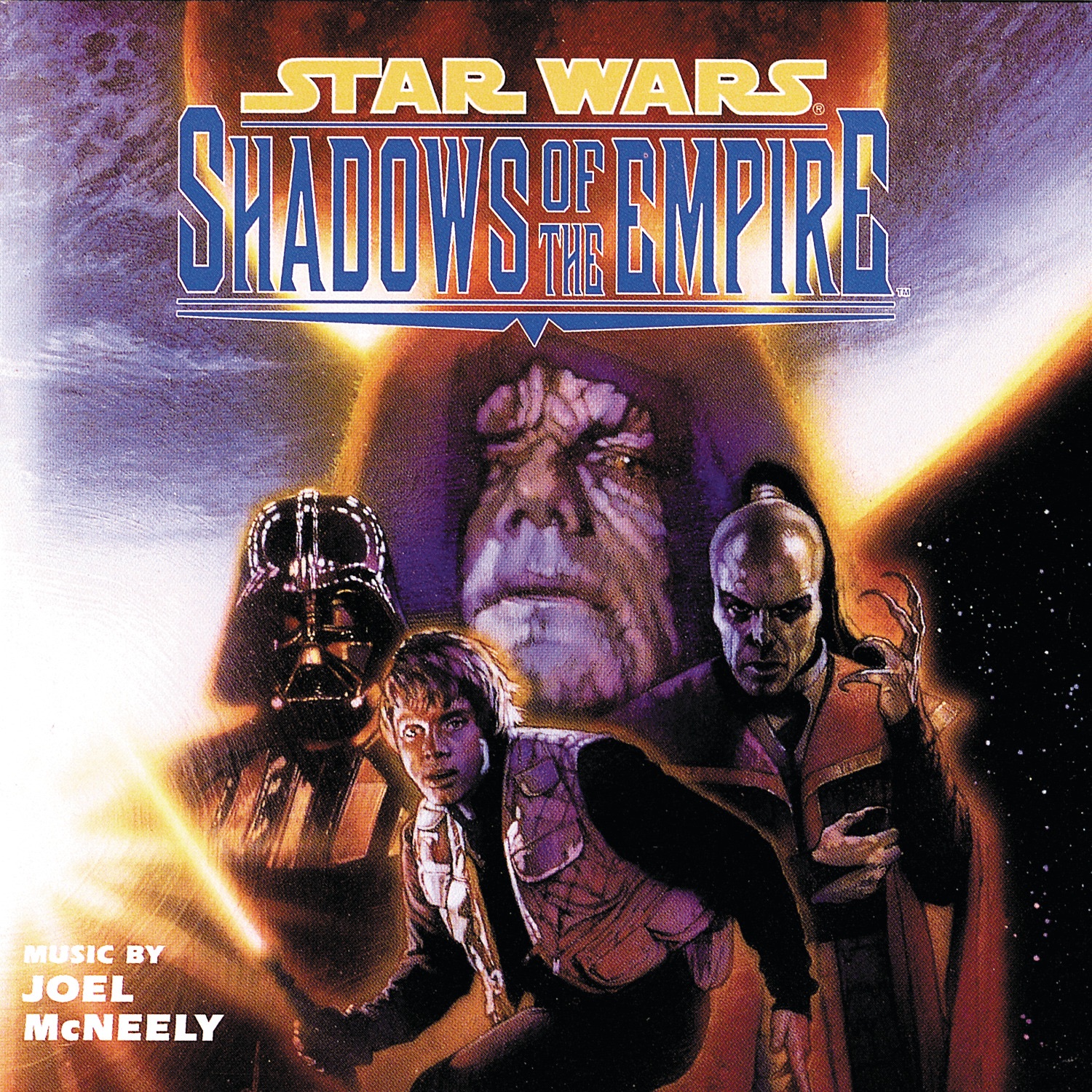
Shadows of the Empire
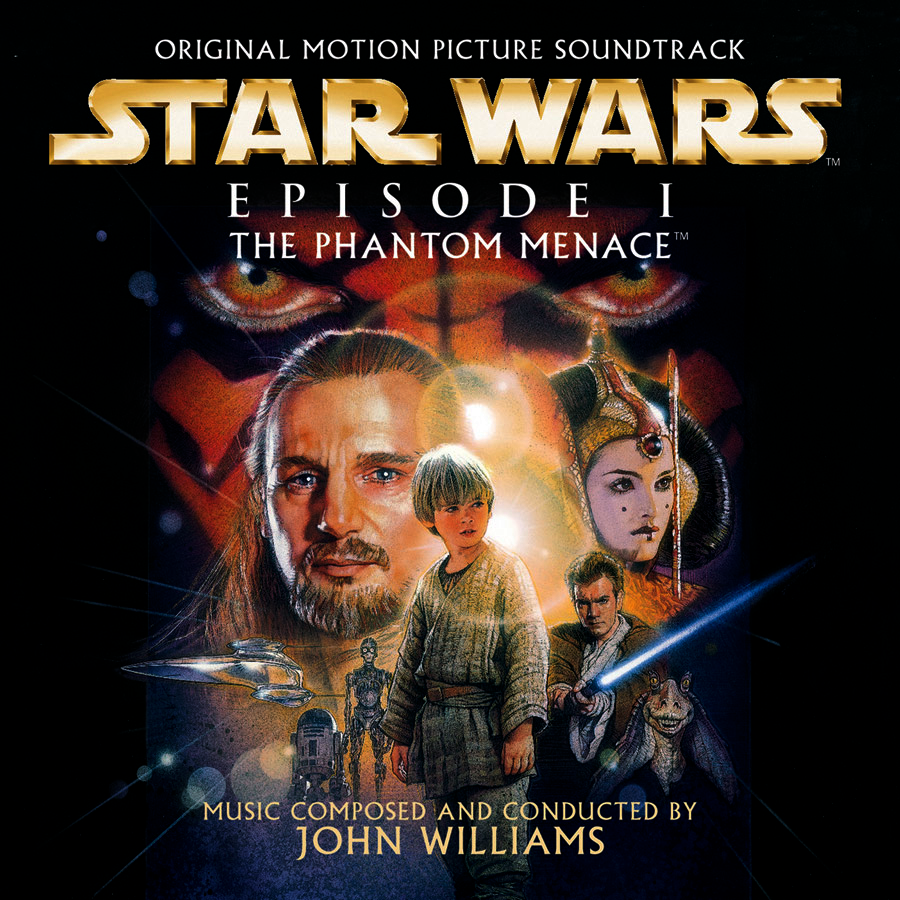
Sony Classical CD.
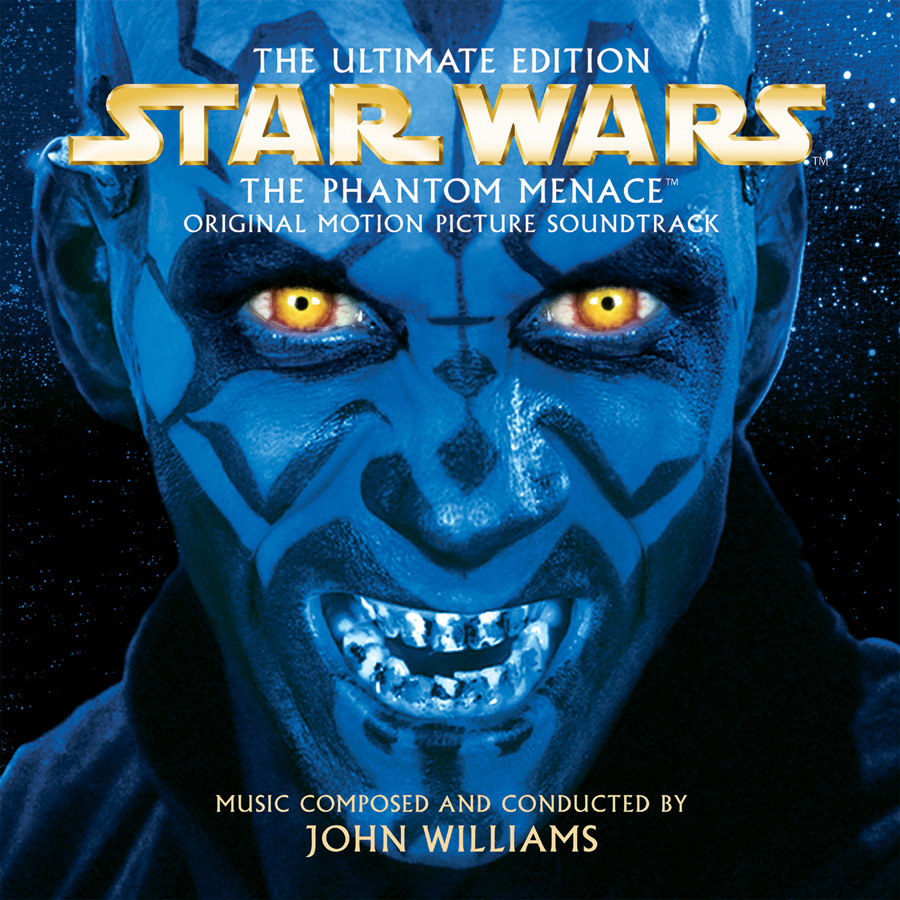
Sony Classical CD - The Ultimate Edition.
Now available on Walt Disney Records (2018) as a remastered CD presenting the major highlights, albeit out of film order.
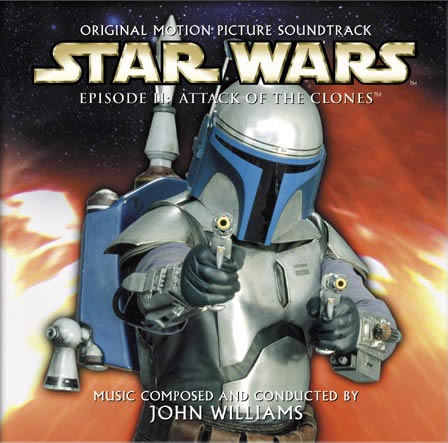
Jango Fett.
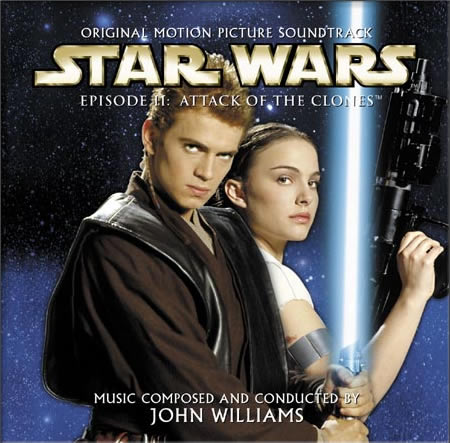
Anakin and Padmé.

Yoda.
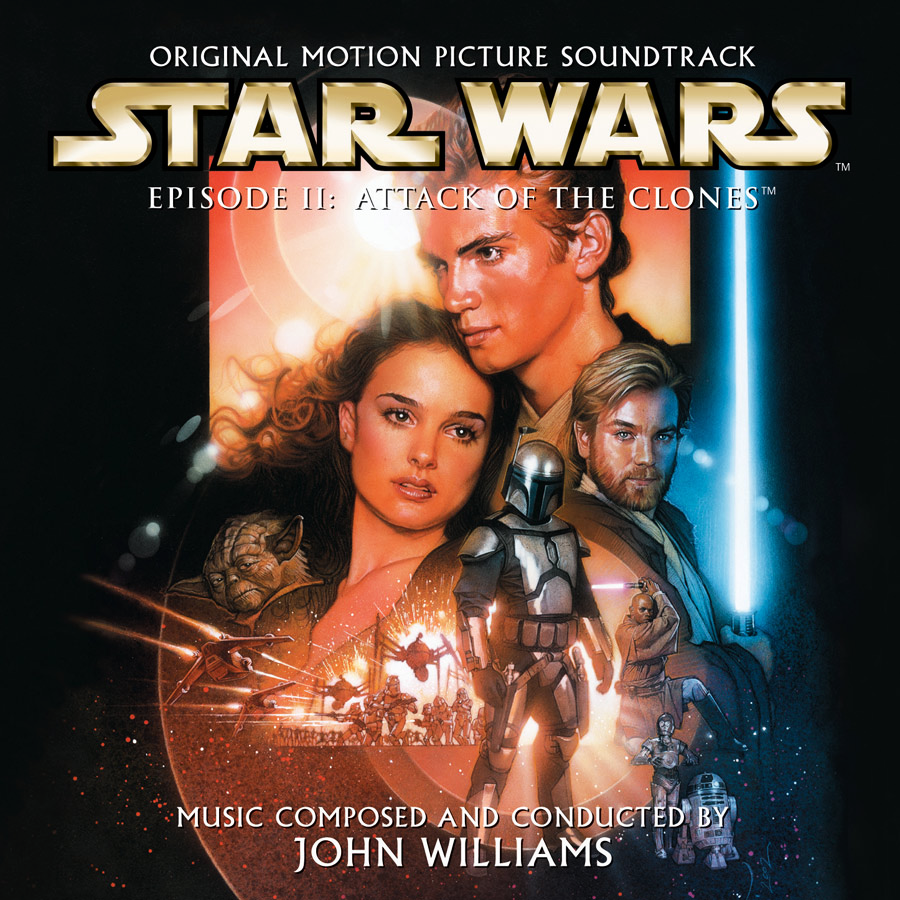
Movie poster art.
Now available on Walt Disney Records (2018) with only 1 CD not presenting the complete score.
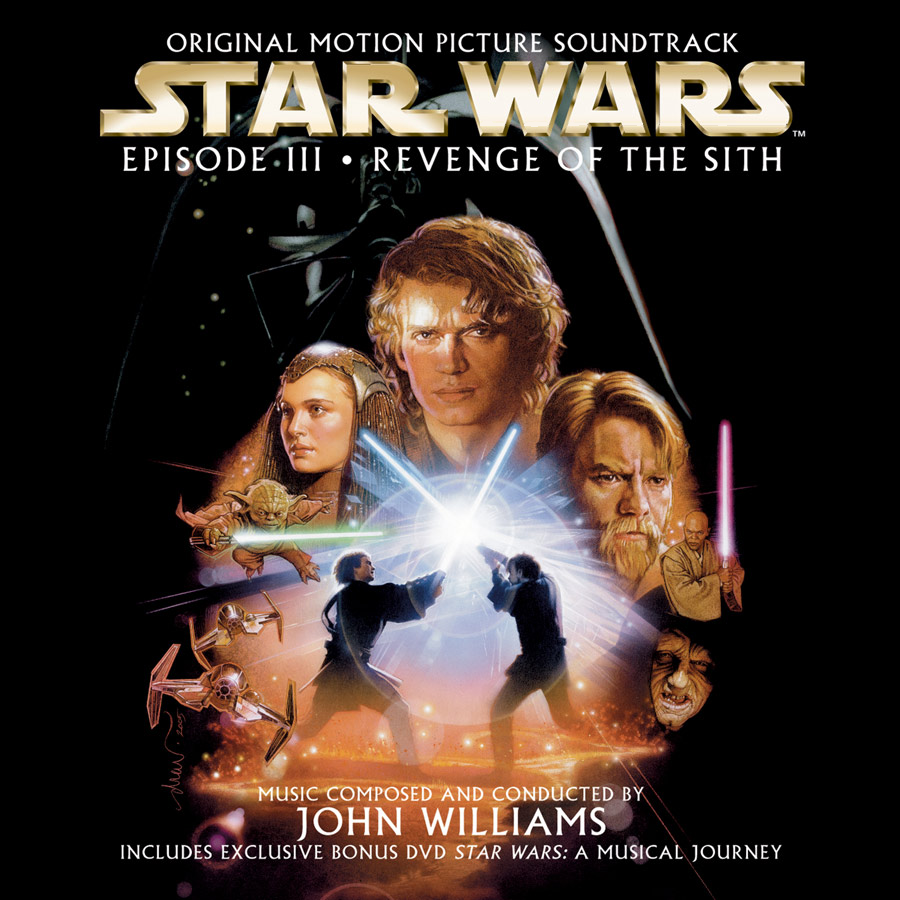
Sony Classical CD.
Now available on Sony (2005) with only 1 CD not presenting the complete score. It is the first soundtrack to have been released with a bonus DVD. The 70-minute DVD, entitled Star Wars: A Musical Journey, presents the major themes of the saga.
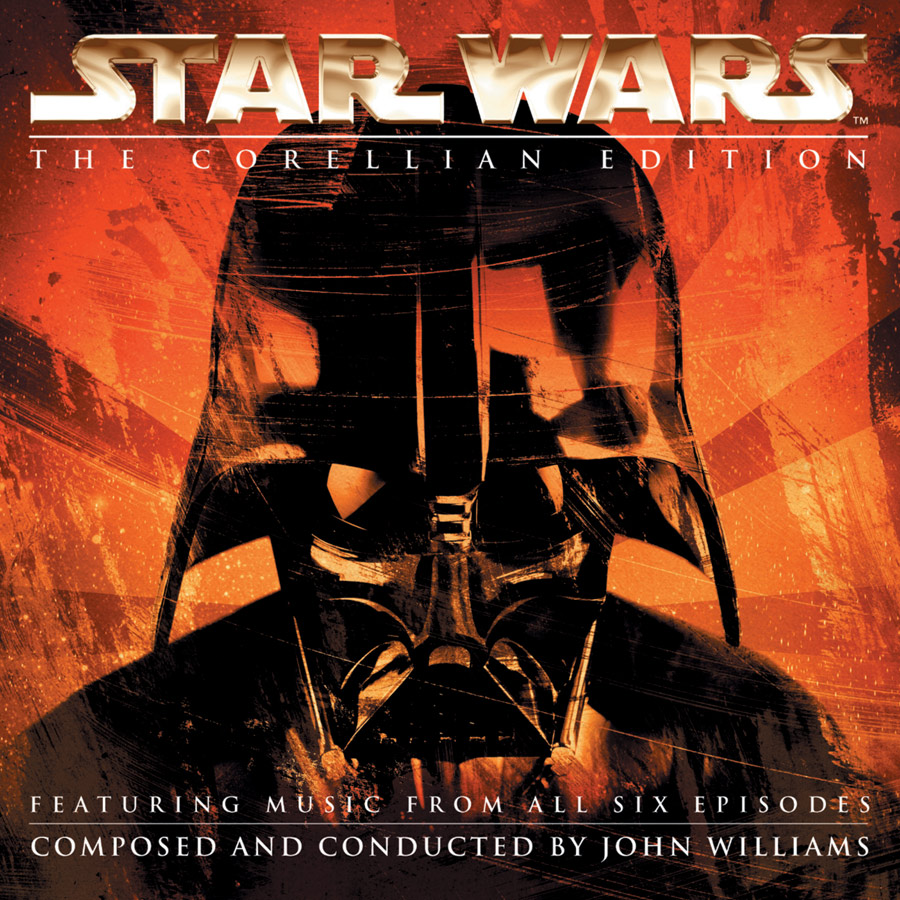
The Corellian Edition
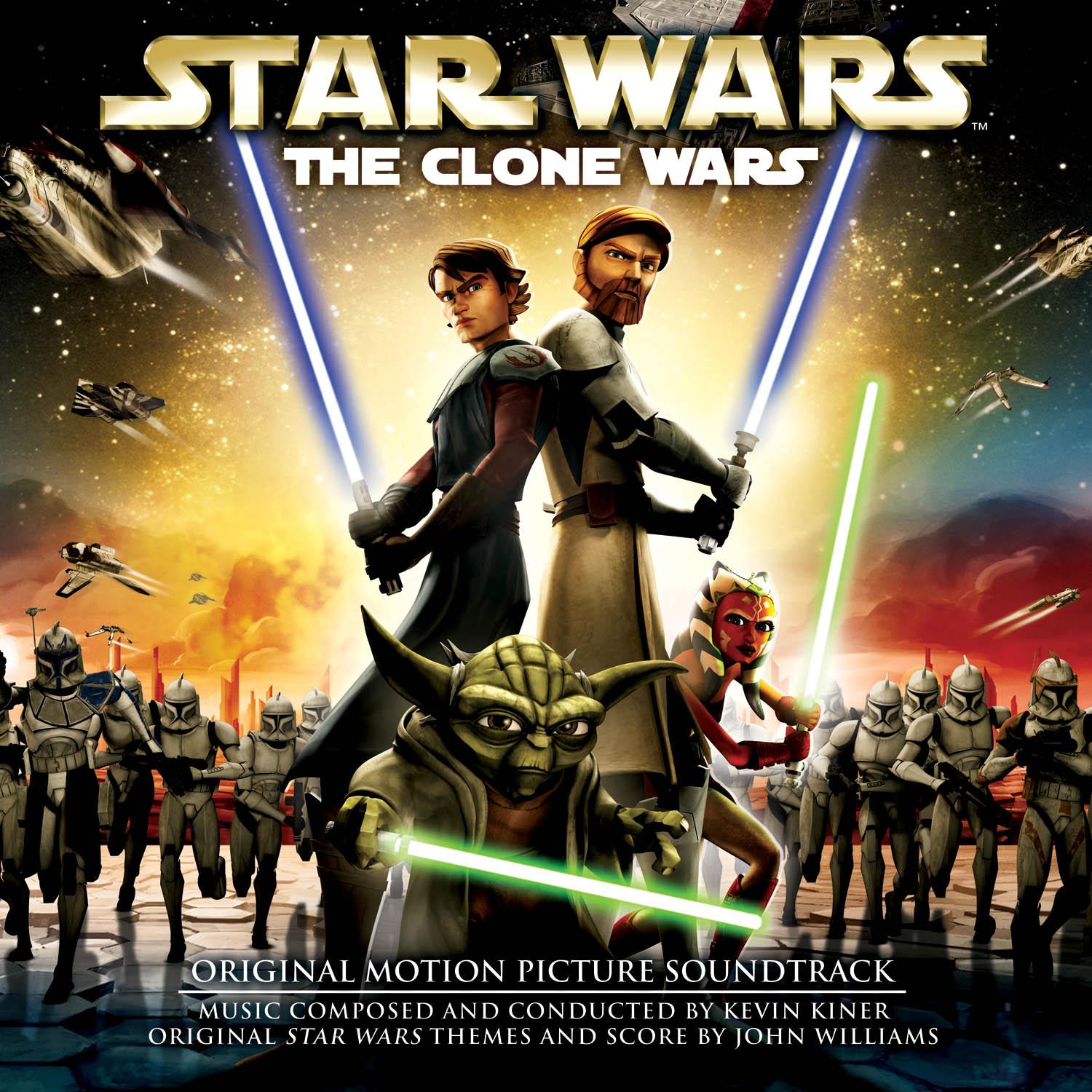
The Clone Wars
While immensely popular, many musicians in the classical music community have accused many of Williams's scores—especially from the Star Wars saga—as being unoriginal. Notably, the scores do seem to draw upon elements of composer such as Holst, Mahler, and, of course, Wagner's operas. The Wagnerian parallel is most easily drawn, with the saga's leitmotifs, heavy use of brass, heroic themes, and perfect intervals.
- One of the most notable examples that is often cited is the track "Main Title/Rebel Blockade Runner" from A New Hope; some claim that the 5/4 ostinato is blatantly borrowed from Holst's Planets Suite. Tutti dissonant chords appear repeatedly throughout the film, and are no doubt intentionally imitating the "sounds of war" Holst brought to his composition.
- Some claim that the Star Wars main theme is derivative of the Kings Row film score by Korngold, namely in terms of orchestration and melody.
- Music from Tatooine is always compared to Stravinsky'sThe Rite of Spring, with its heavy use of double reeds over alternating semitones. This theory is supported by reports of Lucas using The Rite in a temp track for the film.
- The Throne Room seems to be derivative of the Pomp and Circumstance Marches by Edward Elgar. Additionally, a section of Dvorak'sNew World Symphony seems to be quoted in the melody.
- The Imperial March is quite similar to Mahler's second "Resurrection" symphony, especially in terms of the first few intervals. Coincidentally, Imperial March is also the title of a work by the aforementioned Edward Elgar (Op. 32).
- Battle of the Heroes bears a striking resemblance to the Dies irae in terms of melodic contour. This is appropriate, as the latter is often used in pieces representing armageddon.
To be fair, Williams was most likely trying to capture a feel that he felt other composers had succeeded to acquire, and it is not beyond the imagination that George Lucas actually requested a score similar to that of other composers.
- Once Upon a Galaxy: A Journal of the Making of The Empire Strikes Back
- Score / how we got here (Some Globe noms tuned out by Oscar) on Hyperspace
- Post Notes: The Score Begins on Hyperspace